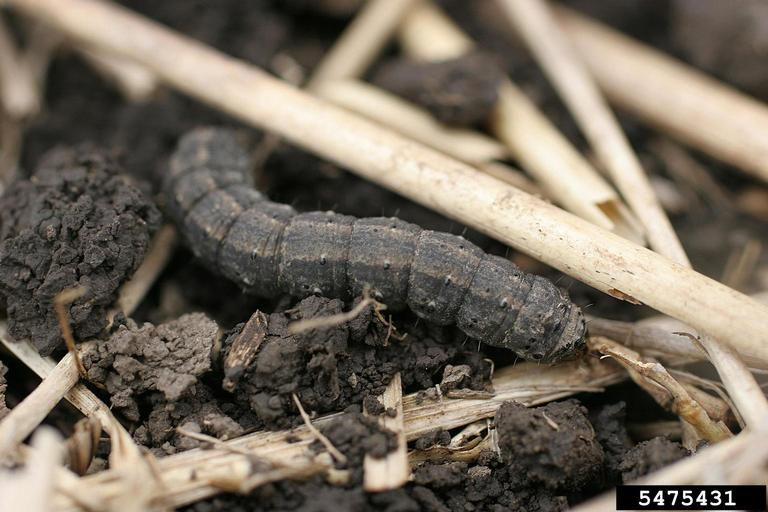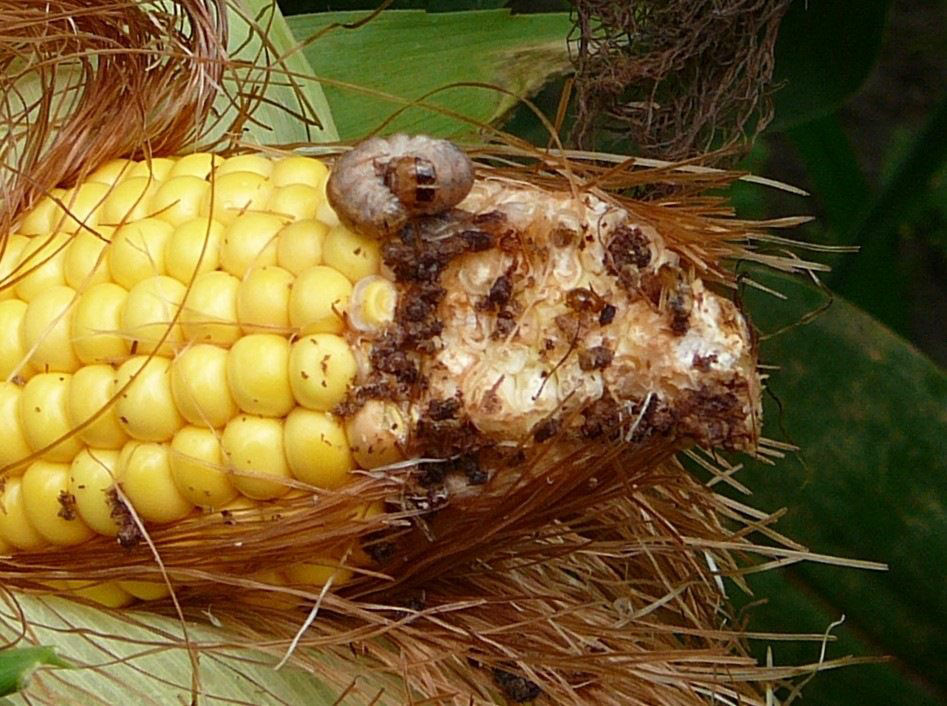Management and Identification of Common Cutworms in Corn
June 12, 2024
- Early season feeding from cutworms can cause economic damage.
- Scouting and identification are keys for management.
- Corn traits, seed treatments, and soil insecticides offer control or suppression of cutworms feeding on seedlings.
- Corn traits and foliar insecticides offer protection against western bean cutworm.
Cutworms are typically an early season corn pest. Identifying cutworms is important, as many species can cause economic damage. Black (BCW), claybacked (CBCW), and dingy (DCW) cutworms are three of the most common species that feed on seedling corn plants, while the western bean cutworm (WBCW) initially feeds on corn tassels before moving to feed on the silks and ear. BCW and CBCW are referred to as “cutting” cutworms because they tend to cut seedlings at or below the soil line, while DCW is referred to as a “climbing” cutworm because it usually climbs plants to consume leaf tissue instead of cutting seedlings.
Economic Thresholds, Scouting, and Management
Corn seedling economic damage can occur when BCW, CBCW, or DCW cut seedling plants off just below or at the soil line. Cutting at this level damages the plant’s growing point, which results in either withered, non-productive plants or death. When scouting for early season cutworm injury, look for leaf feeding, wilted plants, and missing plants. The larvae generally feed at night or on overcast days, so finding them aboveground during daylight is a rarity. Scouting at night with a flashlight may allow observers to see the larvae feeding on the plants. During daylight, look under crop residue and soil clods around cut plants to confirm the presence of cutworms. Small- to medium -sized larvae can be the most destructive as they have the most time to feed before pupating into adult moths.
If BCW and/or CBCW larvae are found, the next step should be determining the percentage of cut plants. First, the overall field plant population should be determined in random field areas by measuring 1/1000th of an acre based on row width in several locations to obtain the best measurement of the plant population. Once the total plant population is determined, compare it to the number of cut plants. Application of postemergence insecticides may be warranted for early season cutworm management when two to three percent of seedlings are cut above the ground and the cutworm larvae are less than 0.75 inch (19 mm) long. If the larvae are longer than 0.75 inch (19 mm), insecticides may be warranted if five percent of seedlings have been cut.1 However, thresholds may vary by state and region, so refer to local university recommendations for economic thresholds and postemergence insecticides. Iowa State University has a downloadable spreadsheet that calculates threshold information based on plant population, percent cut plants, price of commodity corn, expected yield, and the cost of soil insecticide.2
Late season WBCW scouting should be focused on looking for egg masses, which are usually deposited on the top of the uppermost leaves. Foliar insecticides may be warranted when five out of 100 plants are infested with egg masses, based on a random sample of 20 plants in five locations in the field. Waiting to apply the insecticide until the egg masses are purple can help provide a wider window of control.3 Additionally, if a range of egg masses are found, waiting until most of them have turned from white to purple may provide the best control, as the earlier hatchlings will feed on pollen sacs and will not result in economic injury.
Seed Treatments and Trait Technology
Acceleron® Solutions Offering ELITE and BASIC formulations for corn include clothianidin insecticide at a rate of 0.50 mg a.i./seed, which helps protect corn from black cutworm damage. SmartStax® Technology, SmartStax® PRO Technology, Trecepta® Technology, and VT4PRO™ with RNAi Technology corn products contain a Bacillus thuringiensis (B.t.) protein to help protect seedlings from BCW and ears from WBCW.
Cultural Practices for Management
- Removing winter annual weeds with cultivation or herbicides at least one to two weeks prior to planting can help starve small cutworm larvae before crop emergence and may help reduce the attractiveness of corn fields to egg-laying female black cutworm moths.
- Avoid planting a susceptible crop into a field with a history of cutworm problems.
- Avoid planting a susceptible crop after long-standing pastures, meadows, alfalfa, or red clover.4
Cutworm Identification
Black Cutworm
Black cutworm larvae are black to pale gray and can be distinguished from similar species by the convex granules on the abdominal segments (Figure 1). As the larvae grow, they increase in length from 0.25 inch (6.5 mm) at the third instar growth stage to 2.0 inches (5 cm) at the sixth to seventh instar. First- to third-instar larvae feeding creates “shot holes” in the leaves, while fourth- to seventh-instar larvae are likely to cut plants at or below soil level. The larvae may also bore into the stem and tunnel within it.

Black cutworm damage can be particularly severe in weedy, late-planted corn after a soybean crop and in corn planted in flood plains. Wet springs that delay tillage or herbicide burndown applications are often associated with BCW outbreaks. In terms of economic damage, the BCW is the most destructive cutworm species in the Corn Belt and can be found throughout North America. Black cutworm larvae feed on many plants including corn, vegetables, cotton, tobacco, and various weed species.
Claybacked Cutworm
Claybacked cutworm larvae are pale gray, translucent, have a gray-brown head with bars on the front of the face, and a broad yellow-brown stripe on the back (Figure 2). Small larvae pull leaves into a burrow and eat from the leaf tip to the base. Larger larvae cut the leaves or plants just above the ground and drag them into a burrow for feeding. The eating habits of black cutworm and CBCW are similar.

Dingy Cutworm
Dingy cutworm larvae are pale gray to brown with a red tinge and a faint, dark, V-shaped marking on the back of each abdominal segment (Figure 3). The larvae are 0.25 (6.5 mm) to 1.25 inches (3 cm) long. Dingy cutworm larvae overwinter and injure corn seedlings very early in the season; however, in most cases corn plants outgrow DCW injury. Unlike the BCW and CBCW, the DCW is a climbing cutworm that climbs young seedlings to feed on leaf tissue. This species occurs in southern Canada, southward to Utah, and eastward to Virginia. The larvae feed on vegetables, clover, alfalfa, tobacco, wheat, corn, grasses, and broadleaf weeds.

Western Bean Cutworm
Female western bean cutworm moths prefer to deposit eggs on corn prior to tasseling. After hatching, WBCW larvae move to the tassel to feed on pollen sacs. After the third instar, the larvae migrate to the ear to feed on the ear tip or bore into the ear (Figure 4). Older larvae have two dark bands behind the head, and younger larvae may have a faint diamond-shaped pattern on the back opposed to two distinct bands. Currently the WBCW can be found as far east as Pennsylvania and Ontario, and in its original home range of Colorado, Idaho, and western Nebraska.3

For more information on this mid-season cutworm pest, please read Management of Western Bean Cutworm in Corn.
For more information on identifying cutworm species, please read Identification of Cutworms.
Sources
1Dean, A. and Hodgson, E. 2020. 2020 Scouting recommendations for black cutworm. Iowa State University, Extension and Outreach. ICM News. https://crops.extension.iastate.edu/cropnews/2020/05/2020-scouting-recommendations-black-cutworm
2Hodgson, E. and Tollefson, J. 2009. Dynamic black cutworm action threshold. Iowa State University, Extension and Outreach. ICM News. https://crops.extension.iastate.edu/cropnews/2009/05/dynamic-black-cutworm-action-threshold
3Smith, J.L., Difonzo, C.D., Baute, T.S., Michel, A.P., Krupke, C.H. 2019. Ecology and management of the western bean cutworm (Lepidoptera: Noctuidae) in corn and dry beans—revision with focus on the Great Lakes region. Journal of Integrated Pest Management. 10(1): 27. https://academic.oup.com/jipm/article/10/1/27/5558144
4Boyd, M.L. and Bailey, W.C. 2022. Black cutworm in Missouri. University of Missouri-Columbia. G7112. https://extension.missouri.edu/publications/g7112
Websites verified 4/30/24. 1215_42600